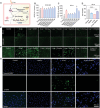Selenium Attenuates Radiation Colitis by Regulating cGAS-STING Signaling
- PMID: 39348242
- PMCID: PMC11600249
- DOI: 10.1002/advs.202403918
Selenium Attenuates Radiation Colitis by Regulating cGAS-STING Signaling
Abstract
Radiation colitis is one of the most common complications in patients undergoing pelvic radiotherapy and there is no effective treatment in the clinic. Therefore, searching for effective agents for the treatment of radiation colitis is urgently needed. Herein, it is found that the essential element selenium (Se) is protective against radiation colitis through inhibiting X-ray-induced apoptosis, cell cycle arrest, and inflammation with the involvement of balancing the generation of reactive oxygen species after the irradiation. Mechanistically, Se, especially for selenium nanoparticles (SeNPs), induced selenoprotein expression and then functioned to effectively restrain DNA damage response, which reduced X-ray-induced intestinal injury. Additionally, SeNPs treatment also restrained the cyclic GMP-AMP synthas (cGAS)- stimulator of interferon genes (STING)-TBK1-IRF3 signaling pathway cascade, thereby blocking the transcription of inflammatory cytokine gene, IL-6 and TNF-α, and thus alleviating inflammation. Moreover, inducing selenoprotein expression, such as GPX4, with SeNPs in vivo can regulate intestinal microenvironment immunity and gut microbiota to attenuate radiation-induced colitis by inhibiting oxidative stress and maintaining microenvironment immunity homeostasis. Together, these results unravel a previously unidentified modulation role that SeNPs restrained radiation colitis with the involvement of inducing selenoprotein expression but suppressing cGAS-STING-TBK1-IRF3 cascade.
Keywords: DNA damage; ROS; cGAS‐STING; radiation colitis; selenium.
© 2024 The Author(s). Advanced Science published by Wiley‐VCH GmbH.
Conflict of interest statement
The authors declare no conflict of interest.
Figures








References
-
- a) Al‐Sarraf M., LeBlanc M., Giri P., Fu K. K., Cooper J., Vuong T., Forastiere A. A., Adams G., Sakr W. A., Schuller D. E., J. Clin. Oncol. 2023, 41, 3965; - PubMed
- b) Mariados N. F., Orio P. F., Schiffman Z., Van T. J., Engelman A., Nurani R., Kurtzman S. M., Lopez E., Chao M., Boike T. P., JAMA Oncol. 2023, 9, 511; - PMC - PubMed
- c) Zhang H., Zhang Z., Yuan S., Precis. Radiat. Oncol. 2023, 7, 237.
-
- a) Wedlake L. J., Proc. Nutr. Soc. 2018, 77, 357; - PubMed
- b) Liu S., Jin J., Precis. Radiat. Oncol. 2022, 6, 4.
-
- Cleveland N. K., Torres J., Rubin D. T., Gastroenterology 2022, 162, 1396. - PubMed
MeSH terms
Substances
Grants and funding
LinkOut - more resources
Full Text Sources
Research Materials
Miscellaneous
